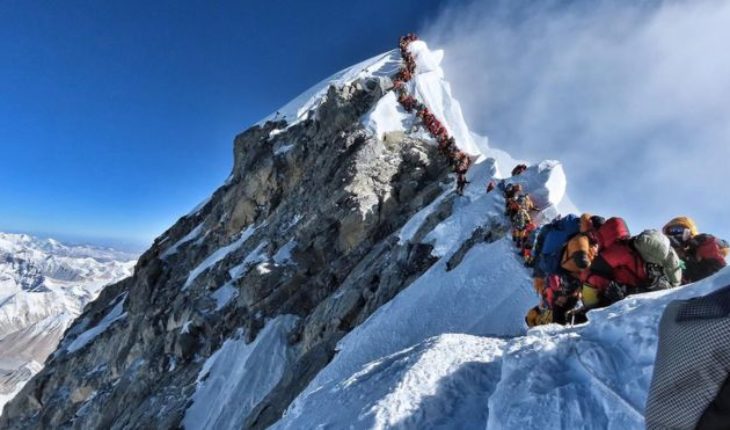If you can imagine the top of Mount Everest, what V EAS is a snowy and quiet peak away from civilization.
But a surprising photo, taken by the Mountaineer Nirmal Purja, shows how in real life this site can be much more crowded.
Purja’s photo has caused interest throughout the world, amid the tragic news that eight climbers died on Everest in the last week.
The image gives an idea of the difficult conditions faced by those who undertake the escalation of the highest peak in the world.
Is it normal to see such long tails near the top?
Yes, according to the guides. This happens quite often during the climbing season.
“It’s normal for a crowd,” says Mingma Sherpa, president of the Seven Summits Treks agency, adding that climbers sometimes queue between 20 minutes and an hour and a half to get to the top.
Jam on Everest: The day we had to make a line to reach the top of the highest mountain in the world and killed several climbers
This often depends on how long the wait lasts for a suitable climbing climate, as mountaineers should avoid possible streams of jets that could hinder the ascent.
“If there is a week (of safe climate), then the summit will not be full. But sometimes, when there is a waiting time of two or three days, it gets very crowded, as all climbers try to reach the summit at the same time, “says the BBC Mingma Sherpa.
Nor is it the first time that the crowds on Everest appear in the headlines.
In 2012, another photo taken by the German climber Ralf Dujmovits became viral, as it showed what he called a “conga line” of mountaineers on Everest.
Is this dangerous?
Dujmovits, who reached the summit of Everest in 1992 and ascended up to 8,000 meters from the mountain on six other occasions, says that these long lines can be dangerous.
The feat of the double amputee who conquered the Everest
“When people have to wait in line, they run the risk of running out of oxygen and they may not have enough oxygen on their way down.”
In 1992, this happened to him during his descent and he felt like “someone was hitting me with a wooden hammer,” he says.
“I felt I could hardly move forward, I was very lucky to be able to recover enough and eventually make my way safely.”
The traffic jams also endanger the life of the guides. ” When you have winds of more than 15 km/hour, you can not survive without oxygen… You’re losing a lot of body heat. ”
Worse, sometimes the oxygen tanks that are made available to designated climbers are stolen.
“Stealing oxygen at such a height is no less serious than killing someone,” says Maya Sherpa (who came to the top three times) to BBC Nepal.
“The government needs to coordinate with the Sherpas to enforce the rules.”
Why are there jams?
Experts say the crowds on Everest have also increased in recent years, because the expeditions have become more popular.
Andrea Ursina Zimmerman, an expedition guide who reached the peak of Everest in 2016, says that many “bottlenecks” are caused by unsuspecting climbers who “do not have the physical conditions” for the trip.
This puts at risk not only their lives, but also those of the Sherpas that take them to the mountain.
Andrea Ursina Zimmerman and Norbu Sherpa celebrate their return to the base camp. Zimmerman’s husband, the Norbu Sherpa mountain guide, recalls having had an argument at 8.600 feet high with a climber who was exhausted, but insisted on continuing to the top.
“We had a great discussion and I had to tell him that he was risking the life of two Sherpas as well as his. I couldn’t even walk properly, we had to slide it down with ropes. When we got to camp at the base, he was very thankful. ”
How does it come to a crowded summit?
Norbu Sherpa has reached the top seven times. He says it is much more crowded on the Nepali side: Tibet’s side is easier, but the Chinese government issues fewer permits and escalation is less interesting.
On the last ridge from the south side, on the Nepali side, there is only one fixed rope.
When there are many people, “there can be two rows of people, one that goes up and another that goes down the top,” he explains, adding: “Everyone grabs a single rope.”
The most dangerous part is often the descent.
Many people push themselves to the top but, once they reach it, “they lose their motivation and energy on the way down”, especially when they realize that it is a long and crowded trip.
Is it worth reaching the summit?
Dujmovits says that, despite being exhausted, he felt “a total deliverance” when he reached the top.
However, descending safely, even if it has not reached the top, is much more important, he says.
“I lost many friends who died during the descent over the years, many accidents occur during the descent because people are no longer concentrating enough, especially in the case of Everest, where there are large crowds that go up and down.”
“The real summit is actually back at the camp at the base, when you come back you can really feel the enjoyment of everything you’ve done.”
Many expedition guides ensure that reaching the top is immensely gratifying, but being physically prepared and choosing the right time to ascend helps a lot to reduce the risk.
Andrea Ursina Zimmerman on her descent from the Everest summit. Practicing climbing at 7,000 or 8,000 meters is essential for people to know “how their bodies react to those heights,” says Norbu Sherpa.
The guide also encourages their teams to begin the “very early” ascent in the day, so people can descend before they start climbing other climbers.
Zimmerman ascended to Everest from the Tibet side, but deliberately chose to wait one more day before ascending to the summit, so that it would be less crowded.
He was aware that there was a risk that by weather conditions his expedition would end without reaching the summit, but he says it was worth it because she and her husband ended up “alone at the top.”
“I can’t even describe how it feels to be with your husband alone, on top of the world… We arrived at 03:45, waited and saw the sunrise. ”





